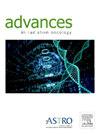正常肺容量选择对局部非小细胞肺癌放射治疗中放射性肺炎风险预测的影响
IF 2.7
Q3 ONCOLOGY
引用次数: 0
摘要
目的本研究旨在评价不同的正常肺体积定义对局部晚期非小细胞肺癌放射治疗患者放射性肺炎(RP)风险预测的影响。方法与材料剂量学变量V20、V5和平均肺剂量(MLD)从纳入NRG肿瘤放射治疗肿瘤组0617试验的442例患者的治疗方案中提取。评估了三种不同的肺体积定义:总肺不含总肿瘤靶体积、总肺不含临床靶体积和总肺不含计划靶体积(TL-PTV)。患者分为no-RP2组(N = 377, RP分级≤1级)和RP2组(N = 65, RP分级≥2级)。统计分析肺容量定义对RP2预测的影响。三种监督机器学习模型——逻辑回归、k近邻(kNN)和极端梯度提升——被用来评估预测性能。采用受试者工作特征曲线下面积对模型性能进行量化,并通过自举分析检验统计显著性。Shapley加性解释(SHAP)用于解释特征对模型预测的贡献。结果统计分析显示V20、MLD与RP2有显著相关性,肺容量定义差异无统计学意义。与其他定义相比,k近邻和极端梯度增强分类器在TL-PTV定义的接收器工作特性曲线值下始终产生更高的面积,这一发现得到了bootstrap分析的支持。SHAP分析进一步表明,V20和MLD是RP2最重要的预测因子。结论与以往研究一致,统计分析和SHAP解释均证实V20和MLD与RP2相关。机器学习模型表明,将正常肺容量定义为TL-PTV对RP2风险的预测效果最高。有必要使用外部数据集进一步验证以确认这些发现。本文章由计算机程序翻译,如有差异,请以英文原文为准。
Impact of Normal Lung Volume Choices on Radiation Pneumonitis Risk Prediction in Locally Non-small Cell Lung Cancer Radiation Therapy
Purpose
This study aims to evaluate the impact of varying definitions of normal lung volume on the prediction of radiation pneumonitis (RP) risk in patients with locally advanced non-small cell lung cancer undergoing radiation therapy.
Methods and Materials
Dosimetric variables V20, V5, and mean lung dose (MLD) were extracted from the treatment plans of 442 patients enrolled in the NRG Oncology Radiation Therapy Oncology Group 0617 trial. Three different definitions of lung volume were evaluated: total lung excluding gross tumor target, total lung excluding clinical target volume, and total lung excluding planning target volume (TL-PTV). Patients were grouped as “no-RP2” (N = 377, grade ≤1 RP) and “RP2” (N = 65, grade ≥2 RP). Statistical analyses were performed to assess the effect of lung volume definition on RP2 prediction. Three supervised machine learning models—logistic regression, k-nearest neighbor (kNN), and eXtreme Gradient Boosting—were used to evaluate predictive performance. Model performance was quantified using the area under the receiver operating characteristic curve, and statistical significance was tested via a bootstrap analysis. Shapley Additive Explanations (SHAP) were applied to interpret feature contributions to model predictions.
Results
Statistical analyses showed that V20 and MLD were significantly associated with RP2, while differences among the lung volume definitions were not statistically significant. Both k-nearest neighbor and eXtreme Gradient Boosting classifiers consistently yielded higher area under the receiver operating characteristic curve values for the TL-PTV definition compared to the other definitions, a finding supported by bootstrap analysis. SHAP analysis further indicated that V20 and MLD were the most influential predictors of RP2.
Conclusions
In line with previous studies, both statistical analysis and SHAP interpretation confirmed that V20 and MLD were associated with RP2. The machine learning models indicated that defining normal lung volume as TL-PTV yielded the highest predictive performance for RP2 risk. Further validation using external data sets are warranted to confirm these findings.
求助全文
通过发布文献求助,成功后即可免费获取论文全文。
去求助
来源期刊

Advances in Radiation Oncology
Medicine-Radiology, Nuclear Medicine and Imaging
CiteScore
4.60
自引率
4.30%
发文量
208
审稿时长
98 days
期刊介绍:
The purpose of Advances is to provide information for clinicians who use radiation therapy by publishing: Clinical trial reports and reanalyses. Basic science original reports. Manuscripts examining health services research, comparative and cost effectiveness research, and systematic reviews. Case reports documenting unusual problems and solutions. High quality multi and single institutional series, as well as other novel retrospective hypothesis generating series. Timely critical reviews on important topics in radiation oncology, such as side effects. Articles reporting the natural history of disease and patterns of failure, particularly as they relate to treatment volume delineation. Articles on safety and quality in radiation therapy. Essays on clinical experience. Articles on practice transformation in radiation oncology, in particular: Aspects of health policy that may impact the future practice of radiation oncology. How information technology, such as data analytics and systems innovations, will change radiation oncology practice. Articles on imaging as they relate to radiation therapy treatment.
 求助内容:
求助内容: 应助结果提醒方式:
应助结果提醒方式:


